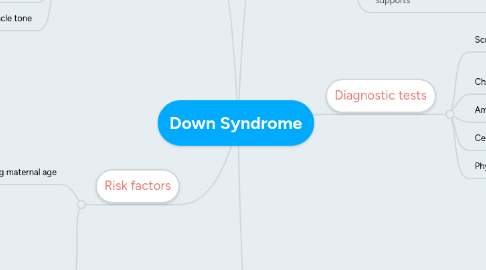
1. Clinical manifestations
1.1. Low nasal bridge
1.2. protruding tongue
1.3. Flat & low-set ears
1.4. Epicanthal folds
1.5. Mental challenges
1.6. Poor muscle tone
2. Risk factors
2.1. Advancing maternal age
2.1.1. Age <30: 1 in 1000 births to 1 in 2000 births; Age >35 rises substantially Age>45 is 3-5%
2.1.2. Occurs 1 in 800 live births
2.1.2.1. increases risk of congenital heart disease, leukemia, and respiratory infections
2.1.2.2. Life expectancy
2.1.2.2.1. 20% die first 10 years
2.1.2.2.2. Some live up to 60 years if survive beyond 10 years
2.1.3. About 3/4 of fetuses are spontaneously aborted or stillborn
2.2. Had have a child with Down syndrome
3. Treatment
3.1. Regular medical checkups can help the child stay in good health condition
3.2. Watch for any early signs of health problems and seek for support
3.3. Help the child develop by providing social skills and emotional supports
3.4. Involve special educators, occupational & physical therapist
3.5. Depends on each child's medical needs and supports
4. Diagnostic tests
4.1. Screening tests
4.1.1. Ultrasound
4.1.2. Blood test- during 1st or 2nd trimester
4.2. Chorionic Villus Sampling
4.3. Aminocentesis
4.4. Cell-free fetal DNA analysis
4.5. Physical exam and baby blood test after birth
5. Genetic variations
5.1. Autosomal aneuploidy
5.1.1. Presence of Trisomy of Chromosome 21 (XXX)
5.1.1.1. Occurs in 97% of the cases
5.1.1.2. Results in each cell has an extra copy in Chromosome 21
5.1.2. Mosaic
5.1.2.1. Occurs only about 1% of the cases
5.1.2.2. presence of an extra copy in chromosome 21 in some of body's cells
5.1.3. Translocation
5.1.3.1. occurs in 3%to 5% of the cases
5.1.3.2. Occurs when a copy of chromosome 21 fuses to another chromosome during interchanging of genetic material
5.1.3.2.1. the interchanging of genetic material between nonhomologus chromosomes
5.1.3.2.2. involves the fusion of the long arms chromosomes 21 and 14, which causes an extra copy of the long arm of chromosome 21
